
Quality Requirements and lighting design for interior lighting of star hotel.
- Categories:Commercial space
- Author:
- Origin:
- Time of issue:2020-08-07
- Views:0
(Summary description)
Quality Requirements and lighting design for interior lighting of star hotel.
(Summary description)
- Categories:Commercial space
- Author:
- Origin:
- Time of issue:2020-08-07
- Views:0
Star-rated hotels refer to hotels whose comprehensive level has reached the star-rated standards set by the state. Different types and styles of hotels have different decoration styles, and they have different requirements for the atmosphere created by the light environment, but the lighting needs of practical functional areas are basically similar. PAK patiently prepares solutions for you from different functional areas, such as hotel lobbies, guest rooms, restaurants, large banquet halls, small meeting rooms, multi-function halls, gyms, leisure areas, etc., and recommends the preferred and suitable selection of lamps for each functional area, providing you with the best star hotel lighting.
This chapter will give you a detailed description of the quality requirements, energy-saving requirements and lighting design for interior lighting of star hotel.
Quality requirements for interior lighting of star hotel
01* Quality requirements for interior lighting of star hotel
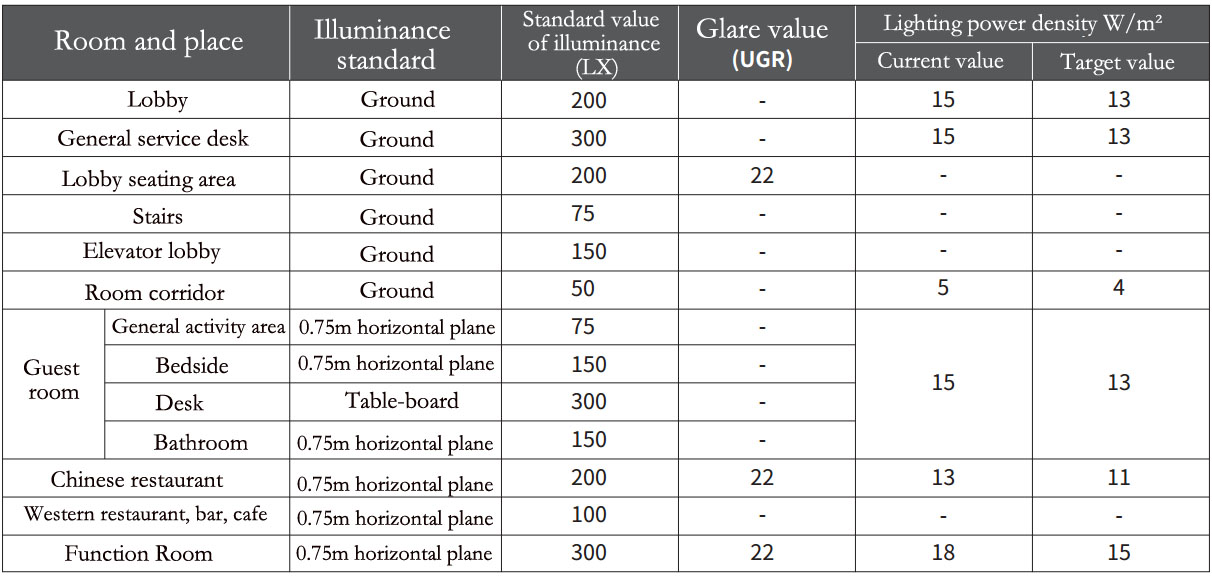
The above data refer to "GB50034-2004 Architectural Lighting Design Standard"
02* Standard value of illuminance(Lux)
The standard values of illuminance specified in the above table are the maintainable average illuminance values in the reference documents. Sufficient illuminance can ensure that consumers see the details of the products clearly and easily choose their favorite products.
03* illuminance uniformity (U0)
The uniformity of illuminance in key operation areas should be >0.6. Insufficient illuminance uniformity can easily cause symptoms such as eye pain and dry eyes.
04*Glare value
A visual phenomenon that causes discomfort or reduces the ability to observe subtle parts or objects due to inappropriate brightness distribution or brightness range, or extreme contrast in the field of view. Glare can make people feel dizzy, affect shopping mood, and affect product sales.
05*Indoor uniform glare value (UGR)
According to the national standard GB50034-2013 "Architectural Lighting Design Standards", the uncomfortable glare of indoor spaces should be evaluated by the indoor uniform glare value (UGR), which is a measure of the discomfort caused by the light emitted by lighting device in the visual environment. The psychological parameter of subjective reaction can be calculated according to the uniform glare value formula of CIE (International Institute of Illumination). The following table shows the relationship between the degree of glare and the unified glare value (UGR).

06*Color rendering index (Ra)
Color rendering is the degree to which the light source presents the true color of the object. The color rendering index is a measure of the color rendering of the light source. It is expressed by the degree of consistency between the color of the object under the measured light source and the color of the object under the reference standard light source. In star hotel design, color rendering is also a main indicator of lighting design. The national standard requires the color rendering index Ra>80. It should be noted that Ra can be reduced to 60 for exhibition halls higher than 6m.
07*color temperature (K)
The colour temperature of a light source is the temperature of an ideal black-body radiator that radiates light of comparable hue to that of the light source. Colour temperature is conventionally stated in the unit of absolute temperature, the Kelvin, having the unit symbol K.
Energy-saving requirements for interior lighting of star hotel.
01* Luminous efficacy
It is the ratio of luminous flux to power. In SI, luminous efficacy has units of lumens per watt (lm/W). When the luminous efficiency of the light source is higher, the power consumption is lower, which means more energy-saving under the same illuminance in the same space.
02*Luminous flux maintenance rate
It is the ratio of the luminous flux of the light source after the designated ignition time to the initial luminous flux. When the luminous flux maintenance rate is higher, the light decay of the light source is lower and the life span is longer.
03*Lifespan and maintenance cost
The longer lifespan of the lamp, the maintenance cost is lower. In the same life cycle, the shorter life lamps are replaced and repaired, the higher the cost and labor cost of replacing new lamps will be.
04*Average lifespan
The time elapsed from ignition to 50% luminous flux maintenance of a group of test lamps. Generally, traditional light sources such as incandescent lamps, halogen lamps, fluorescent lamps, and metal halide lamps are calculated based on the average lifespan.
05*Effective lifespan
Effective lifespan means the lighting hours from the beginning of use to the time when the luminous flux decays to a certain percentage (usually 70%-80% of the initial rated luminous flux). The life of LED light sources or lamps is calculated based on the effective lifespan.
06*Lamp efficiency
Under the same conditions of use, lamp efficiency means the ratio of the total luminous flux emitted by the lamp to the total luminous flux emitted by all light sources in the lamp, also called the light output ratio of the lamp.
07*Lighting power density (LPD)
Lighting installation power per unit area (including light source and electrical components), in watts per square meter (W/m2). In the national standard GB50034-2013, it is stipulated that the power density of hotel lighting should not be greater than the specified value in the following table.
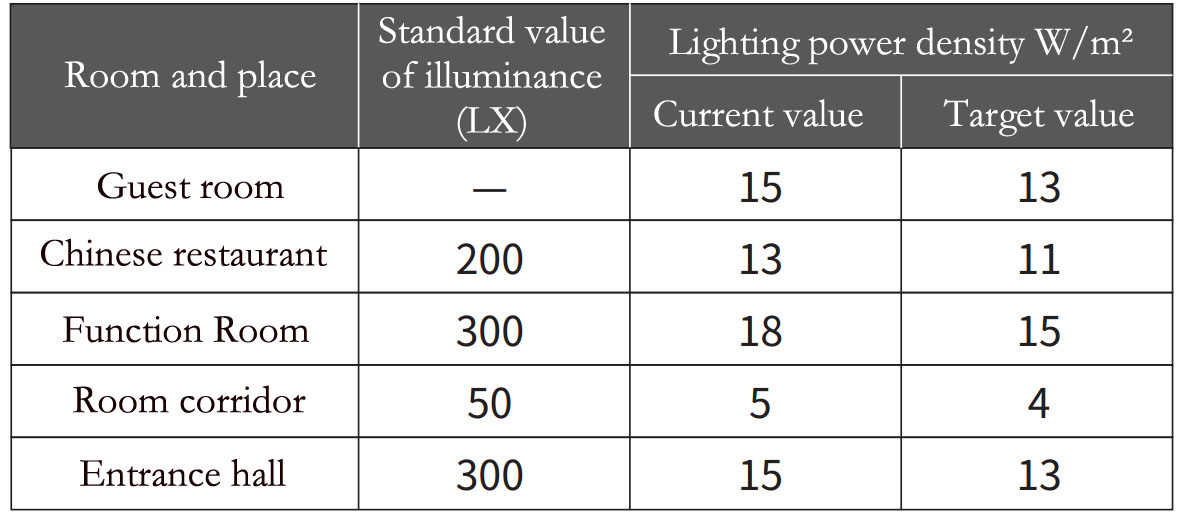
Lighting design for interior lighting of star hotel
01*Classification of star hotels
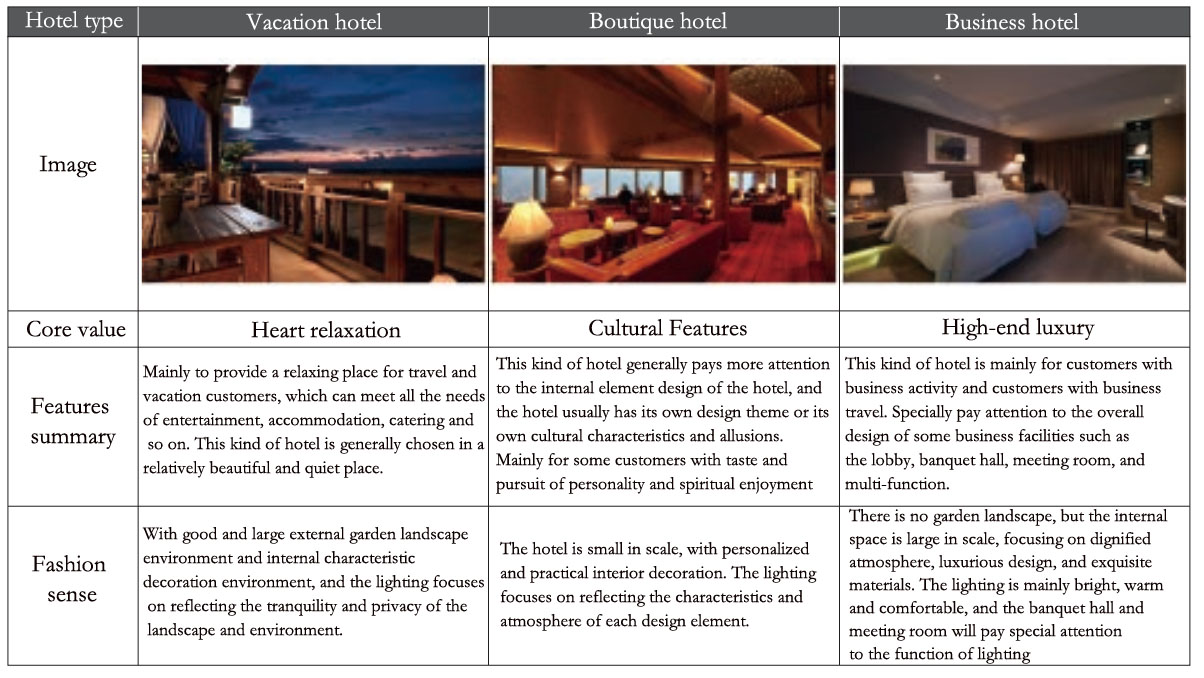
02*The relationship between star hotel type and lighting design
In addition to hardware and software, the quality and image of a hotel depends on the design of the space and the comfort of the environment. The primary factor in creating a high-quality space environment is the creation of the visual environment, which includes the harmony of the environment's tones, the contrast between light and dark, and the comfort of color rendering. Based on this, the hotel's lighting system has become one of the core elements of the hotel's visual environment.
03*Lighting method
Lighting methods can be divided into general lighting, general lighting by area, local lighting, mixed lighting, accent lighting, decorative lighting, scene lighting, etc.
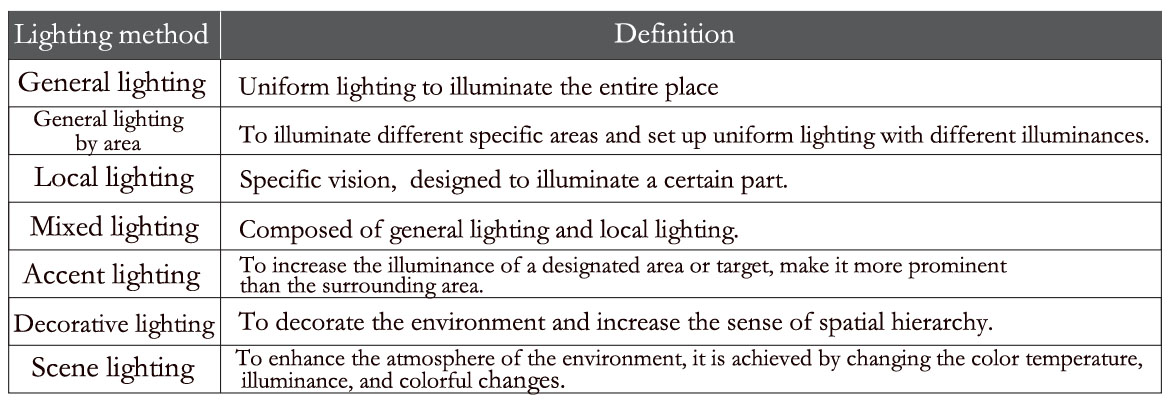
04* Accent lighting coefficients
The effect of accent lighting can be measured by the accent lighting coefficient AF. Different coefficients will cause different visual effects, thereby affecting people's psychology.
Accent lighting factor (AF) = brightness of spotlight/brightness of basic lighting
2: 1 low dramatic effect
5: 1 low dramatic effect
15: 1 Vivid effects (for shop windows)
30: 1 Very vivid effect (for shop windows)
05* Lighting design elements and principles of star hotel

06*Commonly used expression methods in star hotel lighting design
A, ambient lighting
Method (1): Use direct lighting to illuminate the space environment (such as spotlights, downlights or chandeliers)
Method (2): Use indirect lighting-wall washer to illuminate the space environment (adjustable spotlights)
Method (3): Use indirect lighting-wall washer by light slots to illuminate the space environment (such as LED battens, linear lights, LED strips)
B, Artwork lighting
Method (4): The artwork on the wall can be illuminated with wide and narrow beam spotlights;
Method (5): When the artwork displayed on the wall or floor is coherent or large in size, you can use linear lights or multiple wide beams in a row to produce continuous wall wash lighting
Method (6): The artwork displayed on the ground can be illuminated by adjustable or non-adjustable medium and narrow beam spotlights to achieve the lighting effect.
The effect of different beam angles on artworks.
Take spotlight as an example:

Beam angle 15° Beam angle 24° Beam angle 38°
C, Atmosphere lighting
Method: Use lamps with strong decorative effects to highlight the atmosphere and atmosphere of space lighting, and achieve the lighting effect
07* Color temperature selection of star hotel
No matter what type of hotel it is, creating a cordial, warm and comfortable atmosphere is the common pursuit of people. The lighting environment provided by the 3000K color temperature light source can strengthen this characteristic of the hotel. Based on the human visual perception of color temperature and space perception, blue-purple makes people feel mysterious and tense, while orange-yellow makes people feel warm, cordial and relaxed when contrasted.
08*Color temperature and illuminance
The psychological effects of the color temperature of different light sources are very different. As shown in the "Illumination Comparison Table of Indoor Space Lighting Design", along with the illuminance increases, the higher the color temperature, the brighter, fresher and more exciting the visual experience. Therefore, different commercial spaces have different color temperature choices. If the illuminance of general lighting is low and a high color temperature light source is selected, it will produce a deep and dark effect;When the temperature is high and the color temperature is low, it will cause a stuffy feeling. The lighting design should create a good lighting atmosphere according to the overall structure and category of the commercial space. The best design match of illuminance and color temperature is shown in the table of "normal illuminance level and applicable color temperature".
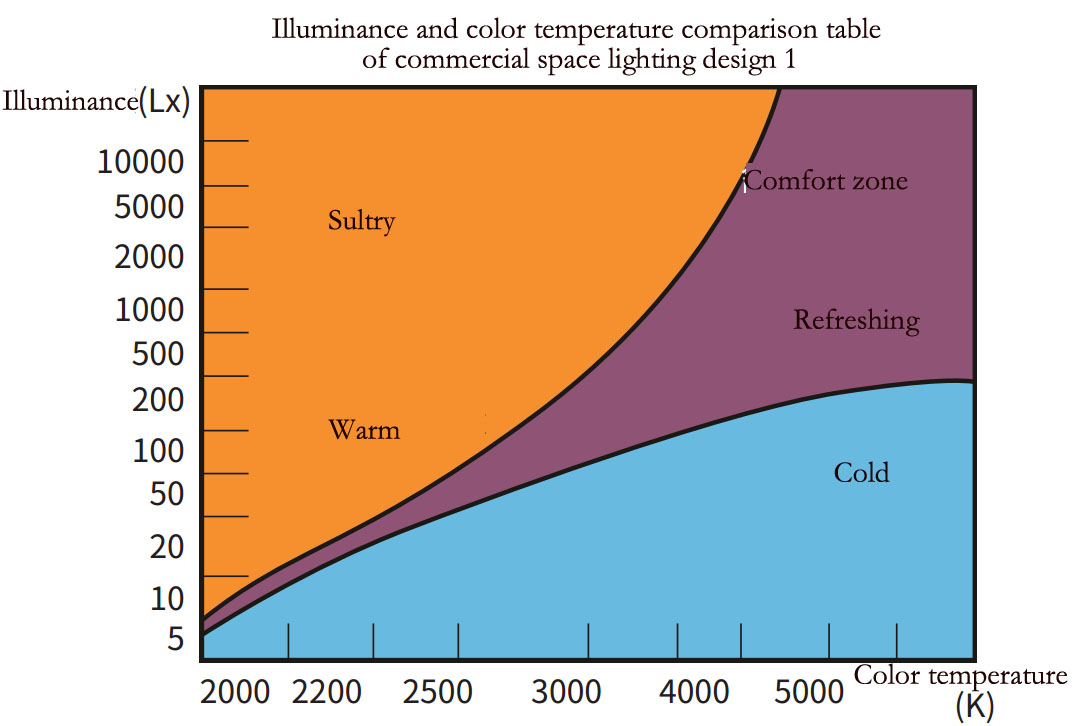
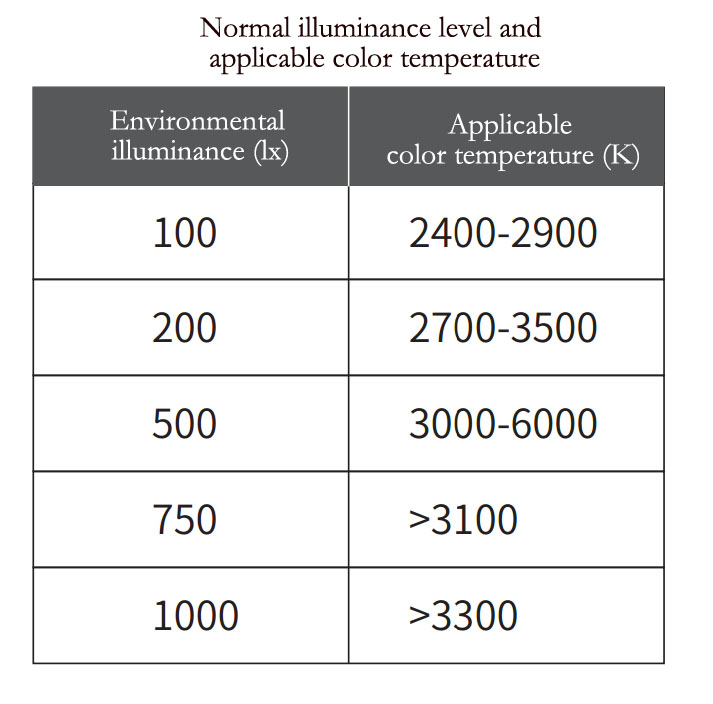
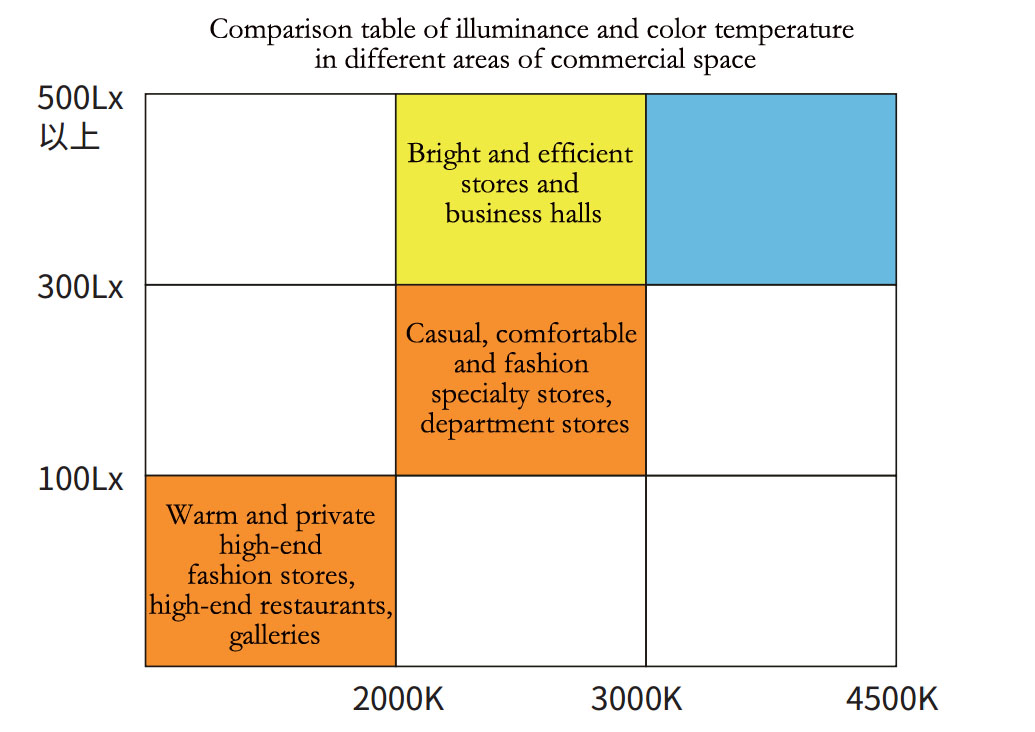
Scan the QR code to read on your phone

